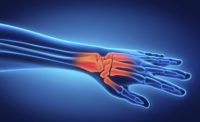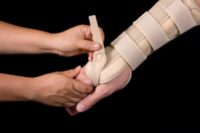Carpal Tunnel Syndrome is a condition affecting the hand and wrist. The carpal tunnel is a space in the wrist surrounded by wrist bones and by a rigid ligament that links the bones together.
Through this small tunnel pass the flexing tendons of the fingers and thumb as well as the median nerve. These tendons attach muscles to bones in the hand and transfer the movement of the fingers from muscles to bones. The median nerve carries signals from the brain to control the actions of the fingers and hand.
It also carries information about temperature, pain and touch from the hand to the brain, and controls the sweating of the hand.
The thumb, index, middle and ring fingers are under the control of the median nerve.
In the carpal tunnel, the tendons of the fingers surround the median nerve. Swelling of the tendons reduces the space in the tunnel and squeezes the median nerve which is softer than the tendons. Pressure on this nerve can injure it.
Such injury results in sensations of numbness, tingling, pain, and clumsiness of the hand. This combination of symptoms is called carpal tunnel syndrome. People with carpal tunnel syndrome experience difficulty in performing tasks such as unscrewing bottle tops, fastening buttons, or turning keys.
How does carpal tunnel syndrome develop?
Bending the wrist or moving the fingers brings muscles and tendons into action. For example, when a person bends a finger, the tendon moves about two inches. The tendons of the hand are encased in sheaths, or sleeves through which the tendons slide. The inner wall of the sheaths contains cells that produce a slippery fluid to lubricate the tendons. Lubrication is essential for the normal and smooth functioning of the tendons. With repetitive or excessive movement of the hand, the lubrication system may malfunction. It may not produce enough fluid or it may produce a fluid with poor lubricating qualities. Failure of the lubricating system creates friction between the tendon and its sheath causing inflammation and swelling of the tendon area. In turn, the swelling squeezes the median nerve in the wrist or carpal tunnel. Repeated episodes of inflammation cause fibrous tissue to form. The fibrous tissue thickens the tendon sheath, and hinders tendon movement.
What are the occupational factors?
The National Institute of Neurological Disorders and Stroke (USA) indicates that carpal tunnel syndrome is "often the result of a combination of factors that increase pressure on the median nerve and tendons in the carpal tunnel, rather than a problem with the nerve itself."
Carpal tunnel syndrome has been associated with certain tasks including:
- Repetitive hand motions.
- Awkward hand positions.
- Strong gripping.
- Mechanical stress on the palm.
- Vibration.
Cashiers, hairdressers, or knitters or sewers are examples of people whose work-related tasks involve the repetitive wrist movements associated with carpal tunnel syndrome. Bakers who flex or extend the wrist while kneading dough, and people who flex the fingers and wrist in tasks such as milking cows, using a spray paint gun, and hand-weeding are other examples. Excessive use of vibrating hand tools may also be related to carpal tunnel syndrome.
A possible link between carpal tunnel syndrome and keyboard or computer use is uncertain. There have been several studies, however most reviews note that there is not consistent evidence to support that extensive computer use is a risk factor. Note that the repetitive motions required for keyboard work may be related to the development of other injuries.
Some studies show that psychosocial factors (such as stress) can contribute to the development of carpal tunnel syndrome.
What are non-occupational factors?
Carpal tunnel syndrome is associated with several diseases and situations. They are:
- Arthritis.
- Diabetes.
- Gout.
- Amyloidosis (infiltration of the liver, kidneys, spleen with a starch-like substance).
- Hypothyroidism (underactive thyroid gland).
- Tumours of tendon sheaths.
- Wrist fractures and dislocations.
- Wrist cysts.
- Pregnancy.
- Use of oral contraceptives.
- Menopause.
All these diseases and situations increase the volume of the contents of the carpal tunnel, resulting in compression of the median nerve. Also some individual factors, such as the size and shape of the wrist and the shape of the median nerve, may contribute to the development of carpal tunnel syndrome.
What are the symptoms?
The typical symptoms of carpal tunnel syndrome are tingling of the thumb, and of the index, middle, and ring fingers, and night pain. The pain awakens the patient, but is often relieved by shaking, hanging, or massaging the hand. Pain may involve not only the hand, but also the arm and the shoulder. Numbness and loss of manual dexterity occur in more advanced cases. Weakness of the hand also occurs, causing difficulty with pinch and grasp. The person may drop objects or be unable to use keys or count change with the affected hand. The skin may dry because of reduced sweating.
How is carpal tunnel syndrome recognized?
People who suspect carpal tunnel syndrome often consult a doctor. The evaluation of occupational carpal tunnel syndrome includes identifying workplace risks. Evaluation begins with a discussion of the person's employment and requires a detailed description of all the processes involved in a typical day's work. It also requires consideration of the frequency, intensity, duration and regularity of each task performed at work. Diagnosis of carpal tunnel syndrome is confirmed by performing certain tests to detect damage to the median nerve.
Tinel's test- The physician taps the median nerve at the wrist. A tingling response in one or more fingers indicates damage to the median nerve.
Phalen's test - The patient puts the backs of the hands together and bends the wrists for one minute. Tingling of the fingers indicates damage to the median nerve.
Electromyography- Electrodes are placed on the forearm and electrical current is passed through the patient. Measurements on how fast and how well the median nerve transmits messages to muscles indicate if there is damage to this nerve.
How is carpal tunnel syndrome treated?
When symptoms of carpal tunnel syndrome are mild or likely to be temporary, treatment includes rest, anti-inflammatory drugs, cold packs, or a splint. Even if a patient wears a splint that has been prescribed, he or she should avoid the activities that caused or aggravate the injury. Where this is not possible, patients should wear the splint after work and particularly during sleeping hours.
Specific exercises supervised by a physical or occupational therapist and yoga can be beneficial.
Surgery may be necessary if the symptoms are severe and if the other measures do not provide any relief. Surgery should not be the first choice for treatment. Even after surgery, a number of patients may still have some problems.
Source: www.ccohs.ca
Canadian Centre for Occupational Health and Safety


